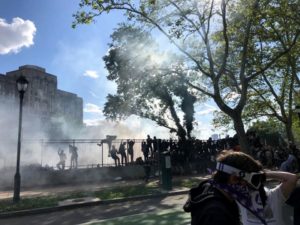LISTEN to this article
On Saturday, June 6 Philadelphians came together for one of the largest protests in the city in decades, demanding justice for George Floyd, victims of police brutality, and all those who face racist oppression.
Approximately 100,000 people assembled by the steps of the Philadelphia Museum of Art in a rally organized by the Party for Socialism and Liberation. Members of the Working Educators caucus of the Philadelphia Teachers Union, Reclaim Philadelphia, Beyond Arrests: Re-Thinking Systematic Oppression, Socialist Alternative, and the PSL spoke about the systematic police violence targeting Black America and the need for liberation from the racist, capitalist system that sustains it.
Rallying at the museum
An hour before the program was set to begin, hundreds of people had already gathered in front of the museum. Members of the PSL set up tents for food, water and medical aid. These were quickly filled by scores of people who were eager to help each other stay safe and healthy during the day’s events. Meanwhile, Girls Rock Philly set up the sound system that would later carry the speakers’ messages to the crowd, with the help of a generator lent by the recently unionized workers of the Philadelphia Museum of Art.
Also early on the scene were a number of large trucks blocking all the on-ramps and off-ramps to I-676. The previous Monday, protesters had peacefully marched onto the highway. Just minutes afterward, without warning, state troopers and SWAT officers began firing mace, rubber bullets and tear gas at the protesters, who desperately tried to escape the constant barrage of tear gas by scrambling up steep hills and climbing over tall fences.

This unprovoked attack caused a great deal of controversy among city officials. Four city councilors introduced a resolution to ban the use of tear gas on civilians, while Mayor Kenney and Police Commissioner Outlaw tried to justify the attack through outright lies that were disproved by aerial footage. As a result, Saturday’s demonstration also became an opportunity for the people of Philadelphia to express their rejection of police repression of protest.
Shortly before the rally got underway, the wide Ben Franklin Parkway was filled with people. From the steps of the museum, one could see hundreds more constantly pouring in from City Hall and the surrounding streets. The flow of people did not stop even after the rally began, growing from tens of thousands to over a hundred thousand. Among those present, there was a tangible sense of awe.
In addition to calling for justice for George Floyd and all victims of racist police violence, the march raised three key demands. First, that the police should be defunded and demilitarized, and that those resources be shifted to public services like education, healthcare, housing and the arts. Second, protesters demanded that Governor Wolf get the National Guard off the city’s streets, where in the previous few days they had acted like an occupying army. Finally, they called for the resignation of Danielle Outlaw, Philly’s Police Commissioner, after she allowed and then lied about Monday’s unprovoked attack by police on peaceful protesters. The crowd voiced their unity with these demands through chants, applause, and the signs they carried.
The rally concluded with a performance by youth drumline Xtreme Cre8tionz. Whatever the enthusiasm of the crowd before, this raised their spirits all the more and prepared them to march on City Hall.
On the march to City Hall
The crowd lined up behind two massive banners demanding justice for George Floyd and an end to police repression, then began their procession down Ben Franklin Parkway. Batala, an Afro-Brazilian drum group based in Philly, lent their rhythm and energy to the march, and even synced up with the chants.
Perhaps the most inspiring moment was a drum-backed rendition of a familiar chant that builds from “I…” to “I believe…” and eventually to “I believe that we will win.” When the whole chant came together, the crowd exploded with energy. At low points in the movement in the past, this message has helped to rekindle people’s morale. But this was different — it was something people felt was immediately true.
Coming full circle
After wrapping around City Hall, the march moved up Broad Street to Spring Garden Avenue, which led it back to the steps of the museum. Aerial footage shows that, from the lead banners to the tail end, it reached nearly a mile — something those on the ground could not possibly conceive. Even standing on the museum steps as the protesters arrived, it was difficult to grasp just how many people were on the move together.
Despite the heat and sun, the people still had energy left when they arrived back at the museum. Mecca Bullock of the PSL, who had emceed the opening rally and led the chants at the front of the march, took her place on the mic once again speaking to what everyone had just seen for themselves — that no matter how violently the police try to suppress the fight for justice, this uprising for Black liberation will continue.





